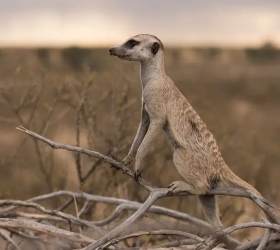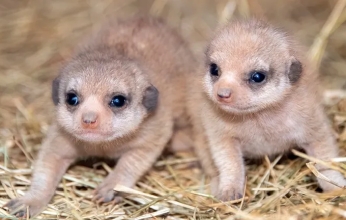  Meerkats are squirrel-size members of the mongoose family that live in the deserts and grasslands of the southern tip of Africa. They have bushy, brown-striped fur, a small, pointed face, and large eyes surrounded by dark patches. They are about 50 centimeters long, including their tail.
Meerkats are squirrel-size members of the mongoose family that live in the deserts and grasslands of the southern tip of Africa. They have bushy, brown-striped fur, a small, pointed face, and large eyes surrounded by dark patches. They are about 50 centimeters long, including their tail.Meerkats live in groups as large as 40, and everyone participates in gathering food, keeping a look-out for predators, and taking care of the babies. These extremely social animals live together in burrows, which they dig with their long, sharp claws. Living underground keeps them safe from predators, and out of the harsh African heat. The burrows can be 5 meters long, and they contain multiple entrances, tunnels, and rooms. A group will use up to five separate burrows at a time.  Meerkats only go outside in the daytime. As the sun comes up, they emerge from their burrows and begin looking for food. They use smell to locate their favorite foods, which include beetles, caterpillars, spiders, venomous snakes and scorpions. They'll also eat small reptiles, birds, eggs, fruit, and plants.
Meerkats only go outside in the daytime. As the sun comes up, they emerge from their burrows and begin looking for food. They use smell to locate their favorite foods, which include beetles, caterpillars, spiders, venomous snakes and scorpions. They'll also eat small reptiles, birds, eggs, fruit, and plants. At the burrow, a few 'babysitters' stay behind to watch over newborn pups. This duty is shared by members of the group. Their job is to protect pups from meerkats in rival groups, who will kill the babies if they can.  Meerkats are able to survive without drinking water; they get the moisture they need from eating roots and tubers, as well as fruits.
Meerkats live in groups of up to 40 individuals, called a gang or a mob. Meerkats don't have to be related to belong to the same group.
Meerkats are able to survive without drinking water; they get the moisture they need from eating roots and tubers, as well as fruits.
Meerkats live in groups of up to 40 individuals, called a gang or a mob. Meerkats don't have to be related to belong to the same group.Meerkat mobs spend a lot of their time grooming and playing together to keep the family a tight unit. A meerkat mob has several burrow systems, complete with toilet and sleeping chambers, within its territory. They move from one to another every few months.  While the mob forages for food, one or more meerkats act as sentries. They find a high point, like a termite mound or fallen tree, and perch on their back legs, scanning the desert for predators like eagles, hawks, and jackals. A sentry who senses danger will let out a high-pitched squeal, sending the group scrambling for cover.
While the mob forages for food, one or more meerkats act as sentries. They find a high point, like a termite mound or fallen tree, and perch on their back legs, scanning the desert for predators like eagles, hawks, and jackals. A sentry who senses danger will let out a high-pitched squeal, sending the group scrambling for cover.Meerkats dig safe places called bolt-holes, where they can hide in an emergency. Meerkats memorize the locations of thousands of bolt holes and can run to the closest one at a moment's notice. If caught in the open by a predator, a meerkat will try to look fierce by lying on its back and showing its teeth and claws. If a group is confronted, the meerkats may stand together, arching their backs, raising their hair, and hissing, in order to fool an attacker into thinking they are a single large, vicious animal.  Meerkats can have up to 8 babies in a litter, in a deep underground birthing chamber lined with grasses. Three to four pups is the norm; babies weigh about 30 grams at birth. Newborns are very small, with very fine, sparse hair. Their eyes are shut, and take 10 to 14 days to open.
Meerkats can have up to 8 babies in a litter, in a deep underground birthing chamber lined with grasses. Three to four pups is the norm; babies weigh about 30 grams at birth. Newborns are very small, with very fine, sparse hair. Their eyes are shut, and take 10 to 14 days to open.Pups stay underground with their mother for the first 4 weeks of life. A meerkat reaches maturity after a year and a half. Occasionally groups of brothers or sisters will leave together to form their own mob, or join another.  Meerkats can kill venomous snakes, often working together. Some snakes prey on meerkats and their young in their underground tunnels. Because of this, meerkats do not tolerate snakes anywhere in their area.
Meerkats can kill venomous snakes, often working together. Some snakes prey on meerkats and their young in their underground tunnels. Because of this, meerkats do not tolerate snakes anywhere in their area. They will attack simultaneously and bite the snake wherever possible. It doesn’t take long for the snake to tire and become overwhelmed by the unrelenting attacks. It also helps that meerkats have a mild immunity to snake venom. |